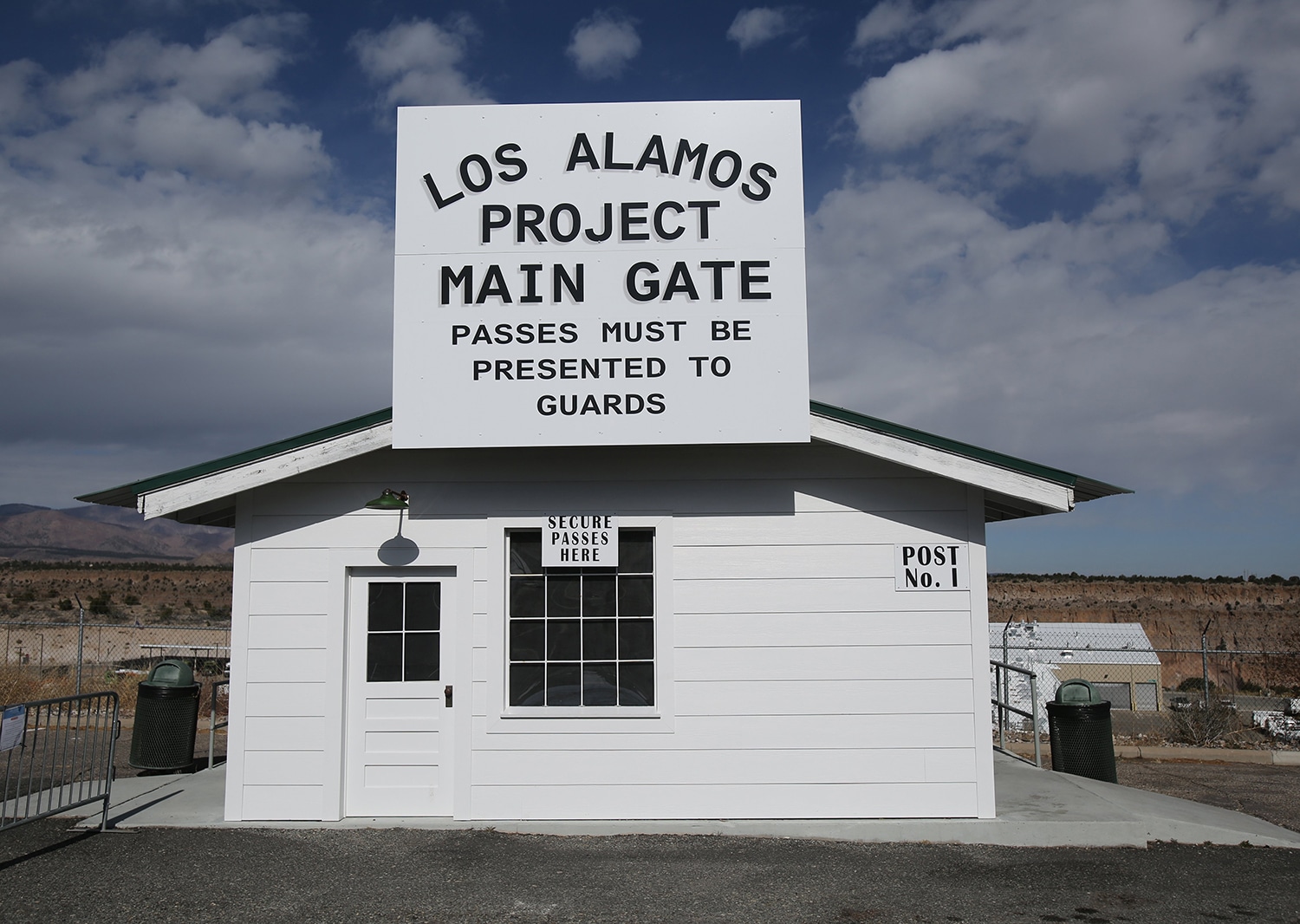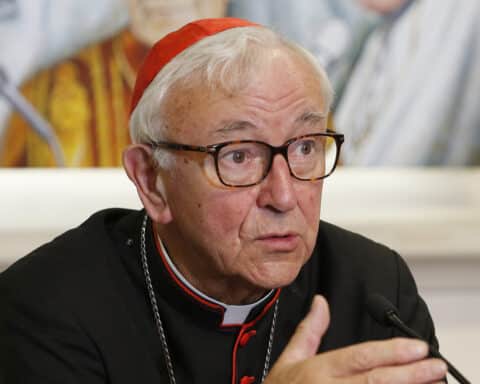(OSV News) — The recently released cinema biopic “Oppenheimer” dramatizes the progressive development, assembly, testing and dropping of the world’s first atomic bomb which then led to the detonation of two bombs over Japan in the twilight days of World War II.
The Bulletin of the Atomic Scientists estimates the U.S. atomic bombings of Japan’s cities of Hiroshima and Nagasaki Aug. 6 and 9, 1945, respectively, killed between 110,000-210,000 people. The range is attributed to both the cities’ own incomplete record-keeping and the sheer scale of destruction.
In the film’s portrayal, delivered by actor Cillian Murphy, theoretical physicist J. Robert Oppenheimer — often called “the father of the atomic bomb” — describes the new weapon as “a terrible revelation of divine power.” Indeed, the film has created an opportunity for Catholic experts in peacemaking and the church’s moral teaching commonly labeled “just war doctrine,” to engage the public with the ongoing physical and spiritual dangers posed by humanity’s apocalyptic invention.
“The use of nuclear weapons would almost always be — especially if they’re strategic weapons — both disproportionate and indiscriminate,” explained Msgr. Stuart Swetland, a moral theologian and president of Donnelly College in Kansas City, Kansas.
A flawed defense
A U.S. Naval Academy physics graduate, Msgr. Swetland spent midshipman summers on deterrence patrols aboard nuclear submarines with the capacity to carry nuclear weapons. Their use, he told OSV News, “would have trouble passing muster of any read of just war theory, because it would not be proportionate to the goal that one is trying to achieve, of peace with justice.”
In addition, Msgr. Swetland said, “it would be indiscriminate — it would not discriminate between combatants and noncombatants. So under both just war criteria in the ‘jus in bello’ analysis, the use of strategic nuclear weapons would always be immoral.”
“Jus in bello” — Latin for “right (conduct) in war” — indicates the moral limits on justifiable conduct during conflict.
The strategic rationale for bombing Hiroshima and Nagasaki — that it avoided a costly land invasion estimated by U.S. military planners to involve 800,000 U.S. deaths and 5-10 million Japanese deaths — is philosophically flawed, according to Msgr. Swetland. “It’s consequentialist thinking to say, ‘We had to do this great evil of destroying cities and their whole populations’ — which is an objectively evil act — ‘to keep us from having to do a land invasion.’ You only can justify that kind of moral reasoning if you’re a utilitarian, not if you’re a Catholic Christian.”
As it turns out, the U.S. Strategic Bombing Survey in its June 1946 report “The Effects of Atomic Bombs on Hiroshima and Nagasaki” — concluded that Japan would have surrendered prior to Dec. 31, 1945, without the atomic bombings or an invasion.
Just war theory
The Catechism of the Catholic Church outlines the moral parameters of “just war,” meaning “legitimate defense by military force,” by stipulating several conditions, including that damage done by an aggressor must be “lasting, grave, and certain”; all other ways of ending a conflict must have failed; the prospect for success “must be serious”; and “the use of arms must not produce evils and disorders graver than the evil to be eliminated.” The catechism adds, “The power of modern means of destruction weighs very heavily in evaluating this condition.”
In 2022, Pope Francis condemned both the use and possession of nuclear weapons as immoral. He also affirmed the importance of “the right to defend oneself” but suggested a reassessment of how the concept of just war is used in favor of constructive dialogue to resolve conflicts.
“I think it’s been evolving in this direction — through the Atomic Age from Paul VI onward — that the Church sees exactly this ominous reality of nuclear weapons, and that they are, by their very nature, indiscriminate instruments of mass annihilation,” David Cortright, professor emeritus at the University of Notre Dame’s Kroc Institute for International Peace Studies in Indiana, told OSV News. “There’s no way that they can fit within the categories of just war teaching.”
Church teaching
The Catholic Church has an extensive history of teaching regarding war and nuclear weapons, including St. John XXIII’s 1963 papal encyclical, “Pacem in Terris“; the Second Vatican Council’s 1965 Pastoral Constitution on the Church in the Modern World (“Gaudium et Spes“); the U.S. Conference of Catholic Bishops’ 1983 pastoral letter “The Challenge of Peace: God’s Promise and Our Response”; and dozens of other official pronouncements.
More recently, Archbishop John C. Wester of Santa Fe, New Mexico, who is making a July 31-Aug. 12 Pilgrimage of Peace to Japan with Archbishop Paul D. Etienne of Seattle, wrote a 2022 pastoral letter “Living in the Light of Christ’s Peace: A Conversation Toward Nuclear Disarmament.”
“We were told — and this is part of what Oppenheimer believed — that nuclear weapons would make war obsolete; that it would reduce war among the great powers and in the world,” Cortright said. “But it obviously has not had that effect. And in many respects, it becomes a shield that allows a state — like Russia, with plenty of nukes — to threaten,” he said. “Whatever happens with (the Russia-Ukraine) war, there must be some reckoning with the role of nuclear weapons in international relations.”
Advocating disarmament
The Arms Control Association’s “2023 Estimated Global Nuclear Warhead Inventories” reports “the world’s nuclear-armed states possess a combined total of over 12,500 nuclear warheads. … 9,600 warheads are in military service, with the rest awaiting dismantlement.” Nearly 90% belong to Russia and the U.S.
The U.S. has 5,244 nuclear warheads; Russia, 5,889; China, 410; France, 290; United Kingdom, 225; Pakistan, 170; India, 164; Israel, 90 (although the country has never confirmed its nuclear capabilities); and North Korea, 30.
The Treaty on the Prohibition of Nuclear Weapons — the first legally binding international agreement to prohibit and eventually eliminate nuclear weapons — took effect Jan. 22, 2021. But only 92 countries out of the U.N.’s 193 member states have signed it. Neither the U.S. nor Russia are signatories.
Msgr. Swetland observed that while commendable disarmament progress has been made in recent decades, “we’re still basing our security — which is in my opinion a quasi-peace, at best — on a very, very immoral structure of sin.”
“It’s immoral to threaten to do what you know is immoral to do,” he explained. “That’s why the deterrence theory — as currently practiced — is based on a structure of sin.”
A problem of economy
A massive amount of resources also are diverted from human development into the maintenance of nuclear arsenals.
“Part of the problem at least is economic — because with war, it’s weapon sales, which promotes profit,” said Johnny Zokovitch, executive director of Pax Christi USA, the international Catholic peace movement founded in the aftermath of World War II.
“So there is this powerful economic driver behind our weapons-making, especially here in the United States. Our number one export is weapons of war,” Zokovitch told OSV News. “We have such an amount of money invested in the current paradigm of nuclear deterrence and nuclear weapons that it’s driven by the economic question.”
Without disarmament and monitoring, risk obviously remains.
The Doomsday Clock — the Bulletin of the Atomic Scientists’ imaginary clock that uses “the imagery of apocalypse (midnight) and the contemporary idiom of nuclear explosion (countdown to zero) to convey threats to humanity and the planet” — has currently reached 90 seconds to midnight.
Reflecting on his submarine nuclear deterrence patrols in the U.S. Navy, Msgr. Swetland said, “Every day, in those circumstances, you’re practicing to play a football game that you hope you’ll never play.”
He added, “But if you ever do play it, you’ve already lost.”





